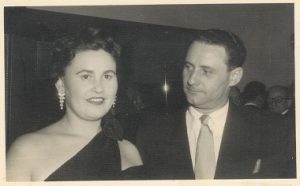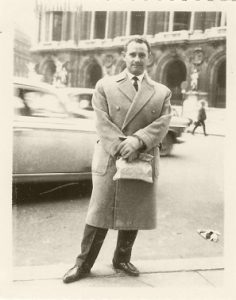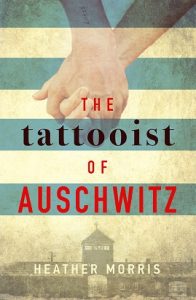On Writing The Tattooist Of Auschwitz

Heather Morris, Author of The Tattooist of Auschwitz. Copyright Steve Morris
The Tattooist of Auschwitz is based on an incredible true story. Those words are stamped on the front cover of my book. What they don’t say is how finding and telling a true story can change the life of the writer forever.
Let me tell you about Lale Sokolov. You can read his story in my book – The Tattooist of Auschwitz. I want to tell you about the 87-year-old, how we met and the friendship we had for 3 years.
We met approximately eight weeks after his wife, Gita, died. I had written several screenplays based on real events.
I was asked to meet Lale as ‘he might have a story worth telling’.
At our first meeting, I deliberately took no writing material or recording device.
For two hours he talked, I listened, but I heard enough to ask him if I could come back the next week.
I did, and for many months I visited Lale 2-3 times a week. I was getting his story out piecemeal, often told at bullet pace with limited coherency and with no flow or connection to the many, many stories he told.
But it didn’t matter. Sitting with him listening to what was essentially the ramblings of an old man was spellbinding. The twisted convoluted story I was starting to make sense of, the significance of which was beginning to dawn on me.
For six months I had no structure, no beginning no end, just vignettes of Lale’s time in Auschwitz Birkenau.

Gita and Lale., Copyright: The Sokolov Family
The one thing that was immediately clear to me was the love story that began in July 1942 when Lale held the hand of 18-year-old Gita, looked into her eyes, her soul, and fell deeply in love with this young girl, her head shaven, dressed in rags, trembling with fear as he tattooed the number 34902 onto her left arm.
Initially, I tried to be professional hearing his story but I very quickly discovered I got more of the deep emotional aspect of events sitting in a café, or having a meal after a trip to a movie.
If this beautiful old man was going to fully open up to me he had to get to know me, the person. On many occasions, my writing and his past didn’t enter our conversations. Our shared love of sport often the dominating topic. Our friendship grew.
I cannot stress how important this approach was in getting to know Lale well enough for him to reveal to me secrets and details of his life in Auschwitz / Birkenau. Lale was taken with my writing his story as a screenplay and often got side-tracked by ‘who should play me, who should play Gita’?

Lale, Copyright: The Sokolov Family
He thought Brad Pitt was, like himself, a good looking boy and a potential candidate, Natalie Portman the only female he would consider for Gita.
Then I took him to see The Notebook. The first time Ryan Gosling came on the screen he stood up in the theatre and loudly proclaimed he was the one, ‘he should play me’. He attempted to encourage the other patrons to agree with him and was given a round of applause.
For writers who, like myself, search for and are lucky to find the amazing true stories that exist but are as yet untold, let me tell you a little of the effect hearing such stories, and being entrusted to tell such stories might have on you.
Yes, this is a warning. A warning of the need to take care of not only the person telling the story but just as importantly yourself.
I spoke to a friend, a social worker, concerned that I was doing harm in allowing Lale to talk at length to me, of what was clearly an incredibly painful time. She instructed me to take it slowly, never push for clarification or further explanation even though I knew there was so much more to tell.
She assured me he would not tell me anything he was not comfortable telling. And this was so true. She also cautioned me on the need to ‘shut him down’ when we had finished talking about his time in Auschwitz/Birkenau. To not leave him in that head-space. I was lucky that sport was something I could come back to, and end my time with him debating who the better tennis player of the day was.
It happened gradually, I was not aware of it initially but my family were.
Like a lizard shedding its skin, Lale shed the horrors and yes survivor guilt, of what he had witnessed, been part of.
Unlike a lizard the discarded skin did not lie on the ground as he moved on, it moved on to me, like a cloak over my shoulders, weighing me down.
 I would return home to my family morose, sullen and not wanting to talk to my husband and adult children. I told myself I needed to protect them from the terrible things that had happened to Lale, someone they had come to know and love. The problem was, who was protecting me?
I would return home to my family morose, sullen and not wanting to talk to my husband and adult children. I told myself I needed to protect them from the terrible things that had happened to Lale, someone they had come to know and love. The problem was, who was protecting me?
Transference, my social worker friend diagnosed. Classic case. When someone had lived through and experienced severe trauma and subsequently found someone they could truly tell the depth of their experience to, they would feel liberated, free from owning their pain outright. They would now have someone to share it with. It was important that I now recognise this and develop strategies to deal with it. I had to detach from his pain, leave it behind when I left him after our visits.
One of the things I did from day one was to keep a journal of our time together.
Under the date I had headings of ‘Event/activity/what we did’ – ‘What I felt/saw/experienced’ – ‘What Lale said’ – ‘What I perceived his emotion to be’.
These entries were invaluable to me when it came to writing the book. They took me back to that kitchen table, the café 2 blocks away we visited often, and once again I was with him, hearing in his words, his story.
I chose to write The Tattooist of Auschwitz in a simple style so that the reader can picture themselves in my place, hearing Lale’s voice only.
As in all adaptations, whether they are from one medium to another, or drawn from the notoriously fragile world of memory, the challenge was for me to select and arrange Lale’s personal testament in a way that was both true to the living memory, and supported by researched facts.
I trust I have accomplished this.
—
Born in New Zealand, Heather Morris lives and works in Melbourne, Australia. In 2003, she met Lale Sokolov, a meeting that changed both their lives. As their friendship grew, he entrusted her with the task of telling the world the innermost details of his life during the Holocaust.
Heather Morris is the author of The Tattooist of Auschwitz published by Zaffre, £12.99
About THE TATTOOIST OF AUSCHWITZ
For readers of Schindler’s List, The Man Who Broke into Auschwitz and The Boy in the Striped Pyjamas comes a heart-breaking story of the very best of humanity in the very worst of circumstances.
I tattooed a number on her arm. She tattooed her name on my heart.
In 1942, Lale Sokolov arrived in Auschwitz-Birkenau. He was given the job of tattooing the prisoners marked for survival – scratching numbers into his fellow victims’ arms in indelible ink to create what would become one of the most potent symbols of the Holocaust.
Waiting in line to be tattooed, terrified and shaking, was a young girl. For Lale – a dandy, a jack-the-lad, a bit of a chancer – it was love at first sight. And he was determined not only to survive himself but to ensure this woman, Gita, did, too.
So begins one of the most life-affirming, courageous, unforgettable and human stories of the Holocaust: the love story of the tattooist of Auschwitz.
—–
‘Extraordinary – moving, confronting and uplifting . . . I recommend it unreservedly‘ Greame Simsion
‘A moving and ultimately uplifting story of love, loyalties and friendship amidst the horrors of war . . . It’s a triumph.’ Jill Mansell
Category: On Writing




Heather, The book sounds amazing! What a gift to have been given to get to know Lale and immortalize his live story with Gita. Just preordered the audiobook! Best of luck!
*love story